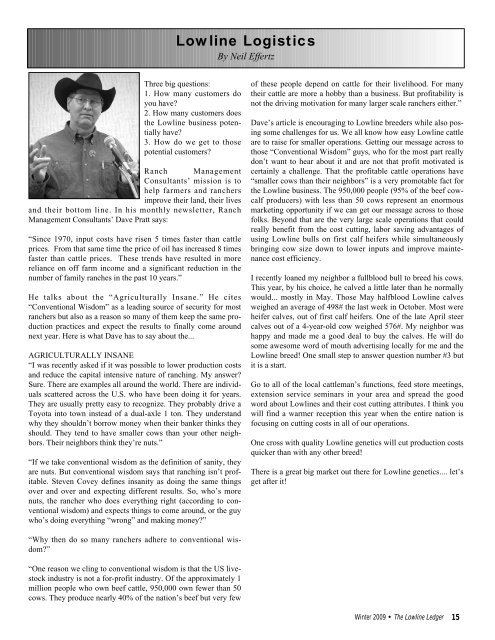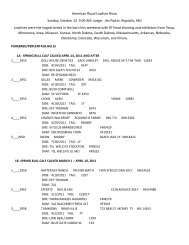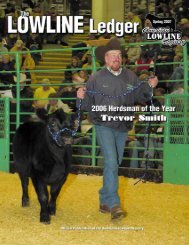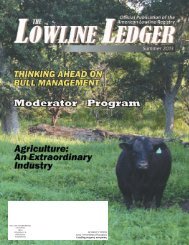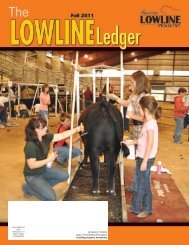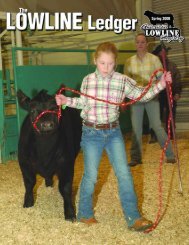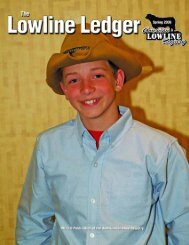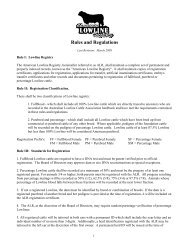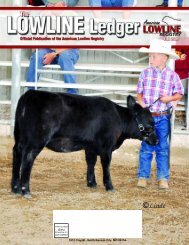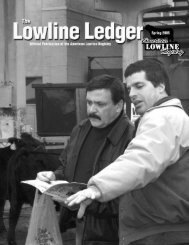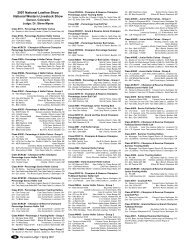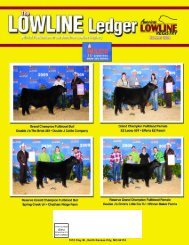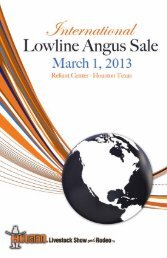1912 Clay St., North Kansas City, MO 64116 PAID - American ...
1912 Clay St., North Kansas City, MO 64116 PAID - American ...
1912 Clay St., North Kansas City, MO 64116 PAID - American ...
Create successful ePaper yourself
Turn your PDF publications into a flip-book with our unique Google optimized e-Paper software.
Lowline Logistics<br />
By Neil Effertz<br />
Three big questions:<br />
1. How many customers do<br />
you have<br />
2. How many customers does<br />
the Lowline business potentially<br />
have<br />
3. How do we get to those<br />
potential customers<br />
Ranch Management<br />
Consultants’ mission is to<br />
help farmers and ranchers<br />
improve their land, their lives<br />
and their bottom line. In his monthly newsletter, Ranch<br />
Management Consultants’ Dave Pratt says:<br />
“Since 1970, input costs have risen 5 times faster than cattle<br />
prices. From that same time the price of oil has increased 8 times<br />
faster than cattle prices. These trends have resulted in more<br />
reliance on off farm income and a significant reduction in the<br />
number of family ranches in the past 10 years.”<br />
He talks about the “Agriculturally Insane.” He cites<br />
“Conventional Wisdom” as a leading source of security for most<br />
ranchers but also as a reason so many of them keep the same production<br />
practices and expect the results to finally come around<br />
next year. Here is what Dave has to say about the...<br />
AGRICULTURALLY INSANE<br />
“I was recently asked if it was possible to lower production costs<br />
and reduce the capital intensive nature of ranching. My answer<br />
Sure. There are examples all around the world. There are individuals<br />
scattered across the U.S. who have been doing it for years.<br />
They are usually pretty easy to recognize. They probably drive a<br />
Toyota into town instead of a dual-axle 1 ton. They understand<br />
why they shouldn’t borrow money when their banker thinks they<br />
should. They tend to have smaller cows than your other neighbors.<br />
Their neighbors think they’re nuts.”<br />
“If we take conventional wisdom as the definition of sanity, they<br />
are nuts. But conventional wisdom says that ranching isn’t profitable.<br />
<strong>St</strong>even Covey defines insanity as doing the same things<br />
over and over and expecting different results. So, who’s more<br />
nuts, the rancher who does everything right (according to conventional<br />
wisdom) and expects things to come around, or the guy<br />
who’s doing everything “wrong” and making money”<br />
of these people depend on cattle for their livelihood. For many<br />
their cattle are more a hobby than a business. But profitability is<br />
not the driving motivation for many larger scale ranchers either.”<br />
Dave’s article is encouraging to Lowline breeders while also posing<br />
some challenges for us. We all know how easy Lowline cattle<br />
are to raise for smaller operations. Getting our message across to<br />
those “Conventional Wisdom” guys, who for the most part really<br />
don’t want to hear about it and are not that profit motivated is<br />
certainly a challenge. That the profitable cattle operations have<br />
“smaller cows than their neighbors” is a very promotable fact for<br />
the Lowline business. The 950,000 people (95% of the beef cowcalf<br />
producers) with less than 50 cows represent an enormous<br />
marketing opportunity if we can get our message across to those<br />
folks. Beyond that are the very large scale operations that could<br />
really benefit from the cost cutting, labor saving advantages of<br />
using Lowline bulls on first calf heifers while simultaneously<br />
bringing cow size down to lower inputs and improve maintenance<br />
cost efficiency.<br />
I recently loaned my neighbor a fullblood bull to breed his cows.<br />
This year, by his choice, he calved a little later than he normally<br />
would... mostly in May. Those May halfblood Lowline calves<br />
weighed an average of 498# the last week in October. Most were<br />
heifer calves, out of first calf heifers. One of the late April steer<br />
calves out of a 4-year-old cow weighed 576#. My neighbor was<br />
happy and made me a good deal to buy the calves. He will do<br />
some awesome word of mouth advertising locally for me and the<br />
Lowline breed! One small step to answer question number #3 but<br />
it is a start.<br />
Go to all of the local cattleman’s functions, feed store meetings,<br />
extension service seminars in your area and spread the good<br />
word about Lowlines and their cost cutting attributes. I think you<br />
will find a warmer reception this year when the entire nation is<br />
focusing on cutting costs in all of our operations.<br />
One cross with quality Lowline genetics will cut production costs<br />
quicker than with any other breed!<br />
There is a great big market out there for Lowline genetics.... let’s<br />
get after it!<br />
“Why then do so many ranchers adhere to conventional wisdom”<br />
“One reason we cling to conventional wisdom is that the US livestock<br />
industry is not a for-profit industry. Of the approximately 1<br />
million people who own beef cattle, 950,000 own fewer than 50<br />
cows. They produce nearly 40% of the nation’s beef but very few<br />
Winter 2009 • The Lowline Ledger 15


